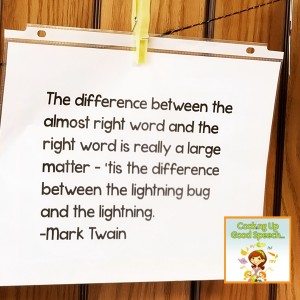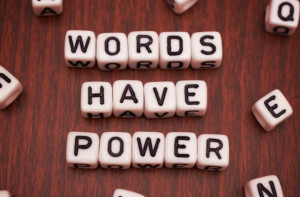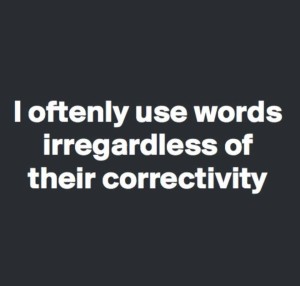 The above quote is hanging up on the wall in my therapy room. It is displayed directly above and in front of the table where my students sit. It has been the focal point of many a therapy session (both planned and unplanned.) Mark Twain’s words have proven to be a valuable source of inspiration and discussion with many of my middle and high school students. First, we take a few minutes to read, and re-read Twain’s quote. I often observe the expressions on their faces to determine if they are making sense of it. Are they having a “light bulb” moment? Are they curious? perplexed? indifferent? Their reactions have run the gamut. But nevertheless, I persist and proceed to work through an explanation of the quote’s meaning and provide them with examples. I was so inspired by the discussions I had with my students that I decided to create a product that could teach them more about word choices. You can find it in my TpT store. So, what did Twain mean when he compared the lightning bug to the lightning? Once I started researching this quote, I found there were so many interpretations, examples and responses.
The above quote is hanging up on the wall in my therapy room. It is displayed directly above and in front of the table where my students sit. It has been the focal point of many a therapy session (both planned and unplanned.) Mark Twain’s words have proven to be a valuable source of inspiration and discussion with many of my middle and high school students. First, we take a few minutes to read, and re-read Twain’s quote. I often observe the expressions on their faces to determine if they are making sense of it. Are they having a “light bulb” moment? Are they curious? perplexed? indifferent? Their reactions have run the gamut. But nevertheless, I persist and proceed to work through an explanation of the quote’s meaning and provide them with examples. I was so inspired by the discussions I had with my students that I decided to create a product that could teach them more about word choices. You can find it in my TpT store. So, what did Twain mean when he compared the lightning bug to the lightning? Once I started researching this quote, I found there were so many interpretations, examples and responses.
Here are a few perspectives:
- The two (a lightning bug and lightning) are nowhere close in comparison. Likewise, Twain meant that the difference between the right word and the almost right word are huge, and the two are nowhere close in comparison. For example confusing a stop light with a stop sign when giving directions or asking for baking soda when the recipe needs baking powder.
- “What is the difference between lightning and a lightning bug? That same HUGE difference is evident between using the right word, and the ALMOST right word. Be accurate, or you may convey a totally different meaning in your communication.”
- A lightning bug emits a small flash of light and is not all that impressive, while a bolt of lightning is a more powerful burst of light, which is much more impressive—and can be compared to the types of words we use in our speaking and writing. He’s saying that in writing, it’s easy enough to find a word that gets the meaning across — but if you can manage to find exactly the right word, you can make the reader sit up and say “Wow, that’s great. “
Here are a few examples:
- It could mean choosing “dazzling” instead of “really bright,” “terrified” instead of “very frightened” and “rarely” instead of “almost never.” In other words, finding one word to express an idea instead of using “helper words” like really, very and almost. For our older students, it shows growth and maturity in their language skills when the better word is used. Here is a FANTASTIC list (shared with permissions) of words that should be considered instead of using “VERY” words.
- As another example: this graphic shows WEAK and OVERUSED words that should always be reconsidered when an attempt is made to use them. REALLY, THINGS, STUFF, NICE, GOOD, AWESOME, LITERALLY, BASICALLY, LIKE, ACTUALLY. These words are vague and should be substituted with words of greater value and clarity.

- Another example to consider is word choice related to the value we place on other people. I learned a LONG time ago to ALWAYS put the PERSON BEFORE the DISABILITY. So, when considering word choice related to people, keep these examples in mind:
SAY: People/individuals with disabilities; an adult who has a disability; a child with a disability
INSTEAD OF: The handicapped; the disabled
SAY: People/individuals without disabilities; typical kids
INSTEAD OF: Normal people/healthy individuals
SAY: A person who has autism
INSTEAD OF: an autistic
SAY: A person who has a learning disability
INSTEAD OF: He/she is learning disabled
SAY: A person who is deaf; he/she has a hearing impairment/ loss; A man/woman who is hard of hearing
INSTEAD OF: The deaf
- Then there are DEGREES of EMOTIONS when discussing word choice—a.k.a. emotional vocabulary. Knowing how to express one’s feelings in the proper manner is crucial, especially as our students mature and are faced with the challenges of the teenage years! Identifying and using the correct emotional vocabulary also helps teach emotional regulation and awareness of one’s true feelings. HAPPY, SAD, MAD just don’t cut it anymore. Whether it involves connecting with ones’s peers, parents, self, or teachers, you will be doing your students a huge favor if you address their communication skills via degrees of emotions. Here is a great reference I found, (free and with permission to share from The Art of Empathy: A Complete Guide to Life’s Most Essential Skill by Karla McLaren, M.Ed. (2013, Sounds True), however I know there are tons of great materials that address this area on TeachersPayTeachers as well!
- Here is yet another example of word choice: Certain word pairs get mixed up all the time. Sometimes it’s because they’re homophones (sound alike/have different meanings/different spellings: advice/advise; affect/effect; led/lead, and sometimes it’s because words are similar enough to cause confusion: anxious/eager; among/between. These are the types of words that I chose to address in the newest product in my TpT store. After researching many lists of commonly confused words, I came up with almost fifty word pairs that I felt were the most relevant and meaningful to the ages, grades and ability levels that I work with. There are certainly many, many more where this came from. I made sure to include a set of blank cards in this product so that you can add as many new words to the game as you would like. In my product, I focused on homophones and other words that easily cause confusion. These are errors I see made quite a bit by my students in their writing and comprehension (oh, and the same mistakes are made by LOTS of us adults as well!) I know my “grammar police” friends are going to greatly appreciate this product!
- “Choosing the Right Word” was designed primarily for middle and high school students and will give them a deeper understanding of word meanings, bring greater awareness of the importance of using the correct word in order to deliver a clear message, and help students know when not to use “lightning bug” when they really mean “lightning!”




I think this statement humorously depicts exactly what happens when we use the wrong choice of words!

And good old Homer Simpson got it right when he has a discussion with his daughter, Lisa, about word choice. Here they discuss jealousy- vs- envy:
(By the way, you can view this video using SafeYouTube (just in case any inappropriate videos or ads pop up while or after viewing!) Check it out here!
Here are some other great resources if you are looking for MORE words that are often confused or used incorrectly. The list really goes on and on. It was so hard to narrow down my words when I was creating this product!
http://grammarist.com/easily-confused-words/ (great word lists!)
https://www.words-to-use.com/ (Oh, how I LOVE this site!!!!!!!)











Leave a Reply